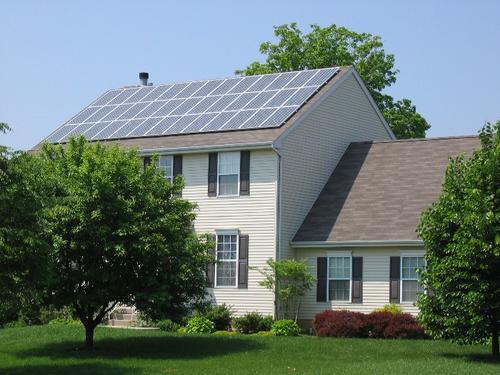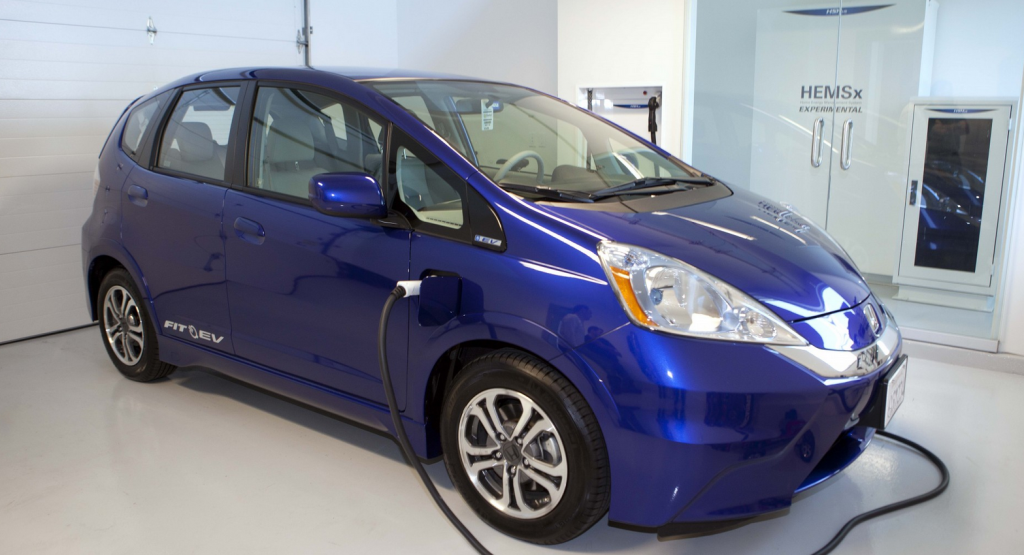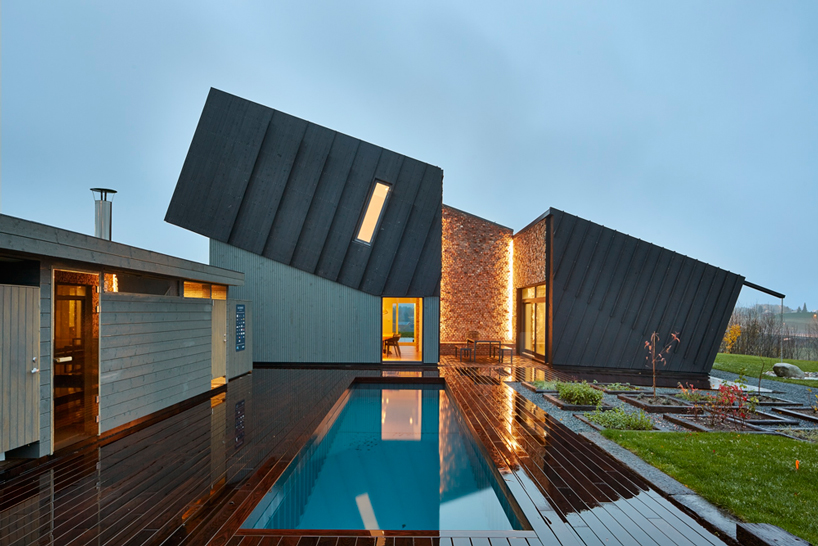Positive Energy Homes are homes that are so energy efficient that they generate more energy than they consume. They are truly the next frontier in green building as they have the potential to create carbon-free electricity. Think of these homes as miniature power plants, supplying clean, renewable energy needed to power a very comfortable home—with surplus energy for other important uses!

A large solar PV system on a high performance home can allow you to generate more energy than your home uses, creating a surplus of energy.
The simplest way to handle surplus energy production from a positive energy home is to sell it back to the utility company, wherever that option is available. Generally, there are five different ways in which utilities handle net positive energy production. Depending on the local utility, the homeowner can receive:
1. No credit for the excess energy. The excess electricity produced by the home “goes down the drain,” e.g. back to the utility.
2. No credit, but the equivalent amount of excess energy goes into a fund that helps others pay their electric bill in times of need. For instance, in Oregon, the Oregon HEAT fund helps low income households with emergency energy assistance during the winter months.
3. A monetary credit for each surplus kWh, but at a lower electric rate per kWh.
4. A monetary credit at the standard kWh rate.
5. A monetary credit at a state-mandated higher kWh rate.
In the first three cases, the homeowner does not get to fully reap the financial benefits of a Positive Energy Home, unless they can literally put that energy to good use. Depending on a homeowner’s specific situation, there are several ways for the owner of a Positive Energy Home to fully utilize the energy that their home is creating.
Plug-in Electric Vehicles
If a positive energy home generates a fairly large amount of excess energy, homeowners could seriously consider the use of a plug-in electric vehicle. Many positive energy homes are designed to do just that.
A simple rule of thumb for the northern U.S. is that 1 kWh of electricity will power an electric car about 3 miles. Depending on local conditions, a 1 kW PV system will produce about 4 kWh per day on average, which will power your car for about 12 miles per day. A 2 kW PV system will produce about 8 kWh per day on average, which will power a car for 24 miles per day. A 3 kW PV system will power a car for about 36 miles per day, or about 12,000 miles per year. In the southern U.S., photovoltaic systems will produce even more kWh each day powering the car even further. If the home is not able to produce enough excess energy to fully power an electric vehicle, then homeowners could also consider the use of a plug-in electric scooter, electric bicycle, or a plug-in hybrid.
Plug-In Hybrids
Plug-in hybrids, sometimes called Plug-in Hybrid-Electric Vehicles (PHEVs), are standard hybrid vehicles with small high-capacity batteries that can be charged by plugging them into an electrical outlet or charging station. Currently, Toyota, Honda, Ford, Chevrolet and BMW make plug-in hybrid models. Plug in hybrids usually have a limited driving range on battery alone. For instance the Toyota Prius can drive 11 miles on a plug-in charge before the 50-mpg gas motor kicks in. For many, this could be sufficient for local driving. The Chevy Volt plug-in hybrid has an all-electric range of 38 miles before the gas motor kicks in.
Vehicle Grid Integration
The emergence and development of Vehicle Grid Integration (VGI) technologies could rapidly change the way we think about our vehicles and how they relate to the electric grid and energy use in buildings. VGI is a system in which plug-in electric vehicles communicate with the power grid to provide or pull electricity to and from the grid as needed. Electric vehicle batteries can essentially be used to store electricity and move it from the vehicle to the grid and back, depending on the electricity usage and needs of the grid at a given moment. In this way, Vehicle Grid Integration allows electric vehicles to act as electric storage batteries for the grid, storing excess electricity in vehicle batteries and drawing on it as needed by the grid, while still powering your electric vehicle.
Other Electric Applications
If a positive energy home does not create enough energy for an electric or plug-in hybrid vehicle, there are many other options, such as powering electric lawnmowers, hedge trimmers, weed whackers and more. Many yard tools have an effective electric option. If you are looking for more luxury, a well-insulated electric sauna is another option!
Existing Positive Energy Homes
Positive Energy Homes are an emerging technology, but there are several great examples of current positive energy homes in use.
Honda Smart Home
Automaker Honda is leading the way with its Honda Smart Home in Davis, California. The home is designed and constructed to be a Positive Energy Home that can power an electric car. The home has a 9.5 kW solar PV system that is expected to generate 2.6 megawatt-hours of excess energy over the course of a year—enough electricity to power a Honda Fit EV for daily commuting.
Norwegian Home Produces More Than Twice the Energy It Uses
Completed in September 2014, this home in Norway generates twice the amount of energy that it uses. Made for the Norwegian Research Centre on Zero Emission Buildings, this experimental house is testing different technologies for operating the house to determine the most energy efficient systems.
Positive Energy Home in Bend, Oregon
The Emerson-Brayfield Positive Energy Home in Bend, Oregon, is typical of the increasing number of positive energy homes that are being built across the country by independent builders for homeowners. This home has about 11 kW of installed solar PV, which supplies 100% of the power needed by the home and powers their Leaf EV, which they use for all their daily local transportation needs. After one year, they still had over 5,000 kWh of excess production and are planning to purchase a plug-in hybrid to replace their regular Prius as their second car. The 5,000 kWh of surplus should power a Prius plug-in-hybrid for at least 11 miles per day, which is the capacity of the plug-in Prius’s electric battery. This will take care of most of the limited local driving for this second car.
Multifamily Building in Alaska
An Alaska architectural firm is partnering with a non-profit housing agency to design and build a positive energy multi-family apartment building for low-income families and residents with disabilities. The project is slated to be the first ever Positive Energy building in Alaska. Presumably, the sale of excess electricity from this apartment building will be used to keep the rent low.

This future positive energy multi-family building in Anchorage, Alaska will generate more energy than it uses.
Turn Your Zero Energy Home into a Positive Energy Home
So, how do you get to positive energy if you currently have, or are planning on building, a Zero Energy Home? There are several ways to transform your Zero Energy home into a positive energy home.
We’d like to hear from you. Do you know of other Positive Energy Homes or are you a designer or builder that builds Positive Energy Homes? Do you live in a Positive Energy Home?
Please share this post, leave your comments below, or feel free to contact us directly to share your ideas.



